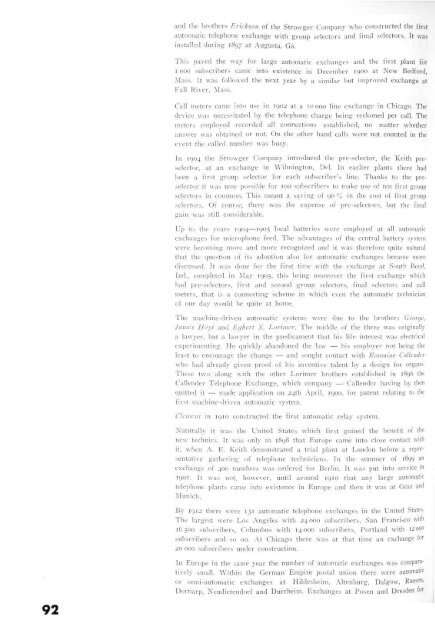contents - History of Ericsson - History of Ericsson
contents - History of Ericsson - History of Ericsson
contents - History of Ericsson - History of Ericsson
Create successful ePaper yourself
Turn your PDF publications into a flip-book with our unique Google optimized e-Paper software.
92<br />
and the brothers Erickson <strong>of</strong> the Strowger Company who constructed the first<br />
automatic telephone exchange with group selectors and final selectors. It was<br />
installed during 1897 at Augusta, Ga.<br />
This paved the way for large automatic exchanges and the first plant for<br />
1 000 subscribers came into existence in December 1900 at New Bedford,<br />
Mass. It was followed the next year by a similar but improved exchange at<br />
Fall River, Mass.<br />
Call meters came into use in 1902 at a 10 000 line exchange in Chicago. The<br />
device was necessitated by the telephone charge being reckoned per call. The<br />
meters employed recorded all connections established, no matter whether<br />
answer was obtained or not. On the other hand calls were not counted in the<br />
event the called number was busy.<br />
In 1904 the Strowger Company introduced the pre-selector, the Keith preselector,<br />
at an exchange in Wilmington, Del. In earlier plants there had<br />
been a first group selector for each subscriber's line. Thanks to the preselector<br />
it was now possible for 100 subscribers to make use <strong>of</strong> ten first group<br />
selectors in common. This meant a saving <strong>of</strong> 90 % in the cost <strong>of</strong> first group<br />
selectors. Of course, there was the expense <strong>of</strong> pre-selectors, but the final<br />
gain was still considerable.<br />
Up to the years 1904—1905 local batteries were employed at all automatic<br />
exchanges for microphone feed. The advantages <strong>of</strong> the central battery system<br />
were becoming more and more recognized and it was therefore quite natural<br />
that the question <strong>of</strong> its adoption also for automatic exchanges became nunc<br />
discussed. It was done for the first time with the exchange at South Bend,<br />
Ind., completed in May 1905, this being moreover the first exchange which<br />
had pre-selectors, first and second group selectors, final selectors and call<br />
meters, that is a connecting scheme in which even the automatic technician<br />
<strong>of</strong> our day would be quite at home.<br />
The machine-driven automatic systems were due to the brothers George,<br />
James Hoyt and Egbert S. Larimer. The middle <strong>of</strong> the three was originally<br />
a lawyer, but a lawyer in the predicament that his life interest was electrical<br />
experimenting. He quickly abandoned the law — his employer not being the<br />
least to encourage the change — and sought contact with Romaine Callender<br />
who had already given pro<strong>of</strong> <strong>of</strong> his inventive talent by a design for organs.<br />
These two along with the other Lorimer brothers established in 1896 the<br />
Callender Telephone Exchange, which company —• Callender having by then<br />
quitted it — made application on 24th April, 1900, for patent relating to the<br />
first machine-driven automatic system.<br />
Clement in 1910 constructed the first automatic relay system.<br />
Naturally it was the United States which first gained the benefit <strong>of</strong> the<br />
new technics. It was only in 1898 that Europe came into close contact with<br />
it, when A. E. Keith demonstrated a trial plant at London before a representative<br />
gathering <strong>of</strong> telephone technicians. In the summer <strong>of</strong> 1899 an<br />
exchange <strong>of</strong> 400 numbers was ordered for Berlin. It was put into service in<br />
1901. It was not, however, until around 1910 that any large automatic<br />
telephone plants came into existence in Europe and then it was at Graz and<br />
Munich.<br />
By 1912 there were 131 automatic telephone exchanges in the United States.<br />
The largest were Los Angeles with 24 000 subscribers, San Francisco with<br />
16500 subscribers, Columbus with 14000 subscribers, Portland with 12000<br />
subscribers and so on. At Chicago there was at that time an exchange for<br />
20 000 subscribers under construction.<br />
In Europe in the same year the number <strong>of</strong> automatic exchanges was comparatively<br />
small. Within the German Empire postal union there were automatic<br />
or semi-automatic exchanges at Hildesheim, Altenburg, Dalgow, Raesen,<br />
Dornarp, Neudietendorf and Durrheim. Exchanges at Posen and Dresden f° r
















